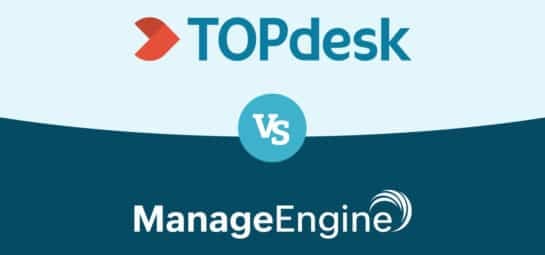Improve your ITSM processes with these tips

ITSM is a strategic approach to designing, delivering, managing, and improving how IT is used within an organization. Ultimately, ITSM is about putting the right processes, people, and technology in place so that you can meet your business goals.
What are ITSM processes?
ITSM processes include Incident Management, Problem Management, Change Management, Asset Management, and Service Level Management, to name just a few. If you're aiming for smoother, faster service delivery, these core ITSM processes are a great place to start making improvements.
Examples of ITSM processes:
- Incident management
- Asset management
- Problem management
- IT change management
So, how can you improve your ITSM processes? This blog post will provide you with some invaluable tips to make your core ITSM processes more efficient.
Incident Management
Incident Management is focused on getting your organization’s services back to normal as quickly as possible, with minimal impact on your core business. When it comes to solving incidents, you sometimes have to rely on temporary workarounds, as long as you identify the root cause afterwards (see: Problem Management).
What is an incident?
An incident is a single event where one of your IT services isn’t performing properly. For instance, a broken printer, or a computer that doesn’t boot properly. According to ITIL principles, callers or service desk employees log an incident after it’s been reported. Open incidents are monitored until they’re resolved or closed.
How to improve your Incident Management process
Implement smart incident categorization and prioritization
Before your service desk can solve an incident, you first need to make sure it’s properly categorized and prioritized, so that it reaches the person or team with the right knowledge for the job. You can group incidents into categories like hardware, software, or network — and even subcategories to specify whether an incident concerns a device issue or an operating system issue.
As well as categorizing incidents so they go to the right people, you need to prioritize them so that the most important ones get picked up first. An incident priority matrix can help you to determine which incidents should be worked on first, based on urgency and impact.
For Dutch hospital Amphia, implementing a single tool for incident registration was the first step on their journey towards ITSM success. With departments now using the same tool, they’ve been able to streamline and automate shared processes like onboarding, which previously required a lot of paperwork and back and forth between service teams. By recording the process in TOPdesk, they were able to set up a sequence of events to immediately set up a new employee’s email account as soon as they join.
Curious how they managed it? Read their full customer story here.
Establish a clear escalation process
In an ideal world, the service agent who gets assigned an incident can handle and resolve it by themselves. But if the issue is more complex than they originally thought, they might need to hand it over to a more experienced or specialized colleague. This is where an escalation process comes in handy.
Perhaps you’d like certain incidents to be passed on to a team or individual based on their seniority or experience level. Or would it make more sense to escalate calls based on function? Or a mix of the two? Whichever escalation procedure makes most sense for your service desk, it’s worth having a set process that everyone can adhere to, to avoid incidents getting lost or bounced back and forth.
Log and use standard solutions
Don’t get caught in the trap of reinventing the wheel every time a ticket comes in. If a new kind of incident pops up, make sure to log the solution so that your service agents don’t have to start from scratch the next time it occurs. Fun fact: TOPdesk's ITSM software uses standardized processes built on best practices, so there’s no need to reinvent the wheel.
Want to take your Incident Management process to the next level? TOPdesk’s Incident Management software makes registering, assigning, and tracking incidents easier than ever.
Problem Management
While Incident Management is all about dealing with issues as and when they arise, Problem Management is focused on identifying the root causes of your incidents so you can prevent them from happening in the future. Think proactive vs reactive. Problem Management can help reduce downtime, improve your overall service quality, and ultimately save your service desk time and money.
How does a problem differ from an incident?
You can describe the difference between a problem and an incident using the analogy of a flat tire. If you hit the curb and get a flat tire that can be fixed by the side of the road, that’s an incident. But if you're driving on a bald tire, that’s a problem that’s bound to lead to an incident.
How to improve your Problem Management process
Use different analysis techniques to get to the bottom of your problems
When it comes to root cause analysis, there’s no one size fits all approach. There are plenty of techniques that service desks use to understand the underlying cause of their problems.
For instance, the ‘5 whys’ method encourages you to keep asking questions until you understand the underlying cause of a problem, rather than relying on assumptions or jumping to conclusions. Other techniques include the Kepner-Tregoe method, or brainstorming with multiple departments to find as many potential solutions as you can. Don’t be tempted to go for a quick fix.
Keep a database of known errors
Have you managed to identify the root cause of a problem? Then you’ve found something called a known error. By keeping a database of known errors, you create a comprehensive archive that your agents can refer back to in the future, so they don’t have to waste time looking for the cause of a recurring problem.
Appoint a Problem Manager
Having a dedicated person responsible for Problem Management can make streamlining your processes a whole lot easier. Not only that — a Problem Manager has the insights you need to track and analyze trends, so you can keep making continuous improvements and adjusting your processes as you go.
Want to get to the bottom of your problems even faster? TOPdesk’s Problem Management feature gives you an overview of your problems and related incidents and helps you analyze and register root causes, so you can start solving right away.
IT Change Management
IT Change Management is an ITSM process that makes it easier for your organization to roll out change requests to your IT infrastructure. Whether the change is complex or simple, a good IT Change Management process helps you to control risk and keep disruptions to your services to a minimum. Improving your Change Management process can help you to implement new changes more quickly, track their process, improve stakeholder communication, and make better cost estimates for proposed changes.
What is a change in IT?
A change in IT can be as simple as replacing a laptop or as complex as introducing an entirely new tool. ITIL recognizes three different types of change:
Standard changes. These are changes to a service or to the IT infrastructure. For example, installing a new printer, or software on a laptop. Here, the implementation process and the risks are known upfront.
Normal changes. These changes have to go through a change process before they can be approved and implemented. And if they’re high risk, a change advisory board can decide whether they should be implemented. A normal change could be moving a new development project into production or adding a new server.
Emergency changes. These are changes that have to be carried out as soon as possible. An example of an emergency change would be dealing with a security breach, requiring a patch to a large number of workstations.
How to improve your Change Management process
Keep stakeholders in the loop
Making sure that your stakeholders are up-to-date about any planned changes should reduce the number of calls your service desk gets when a change is made. Clear communication with the rest of the organization should also ensure that no services are affected due to changes, and that the change can be carried out effectively.
Track the lifecycle of your changes
Keep an eye on your change throughout its entire lifecycle to ensure that it's implemented according to the change plan. This also allows you to see how effective your change process is and helps you identify areas for improvement.
Always have a backup plan
Failing to prepare is preparing to fail. When creating your change plan, it’s always a good idea to create a contingency plan for the worst-case scenario. This can mean the difference between a simple failed change and doing some serious damage to your IT infrastructure.
Want a tool to help you plan, monitor, and evaluate your changes with ease? TOPdesk’s Change Management software makes planning your entire workflow a breeze – from request to evaluation.
Asset Management
IT Asset Management is about managing the lifecycle and inventory of an organization’s IT assets. This includes all the elements of hardware and software your organization uses daily. Done right, ITAM helps organizations lower their IT costs, reduce security risks and improve their productivity.
Read about how Canadian construction company Liebherr-Canada took their asset management to the next level with TOPdesk.
How to improve your Asset Management process
Stay on top of your assets with a centralized inventory
Ever had an important asset that’s gone walkabout or been forgotten entirely? This doesn’t just waste valuable resources; it also puts your organization at risk of a security breach.
Bring your assets together in one central overview. And don’t just register the obvious assets like laptops. Consider all aspects of IT, including data centers, cloud assets, and networks, to get a big-picture understanding of your organization’s available resources.
Get rid of ghosts and zombies
Ghost assets are missing or stolen assets. Physically, they’re nowhere to be found, they’re still in your company’s books. So, you’re paying taxes on an asset that you’re no longer able to use. Zombie assets are the other way around; they’re being used by your organization’s employees, but they're not registered anywhere.
These assets have a spooky name for a reason. They could be costing your organization money, as well as putting your data at risk. Make sure that all of your assets are properly registered to avoid unnecessary purchases or taxation.
Use data to make smarter purchases
You shouldn’t be making IT purchases based on gut feeling alone. With ITAM, knowledge is power. Track how your organization uses assets over time. This gives you all the data to make strategic purchasing decisions, based on operational needs.
Want a clear overview of all your organization’s assets, in one place? TOPdesk’s ITAM software lets you easily register your assets, track their lifecycle, and pinpoint any issues with ease.
Bring your ITSM processes together with TOPdesk
The key to ITSM success is making sure that your processes are aligned with one another. With dedicated features for Incident Management, Problem Management, Change Management, and Asset Management, TOPdesk’s ITSM software gives you a clear overview of your processes, so you can spot gaps and start making improvements right away.
Inspire others, share this blog



